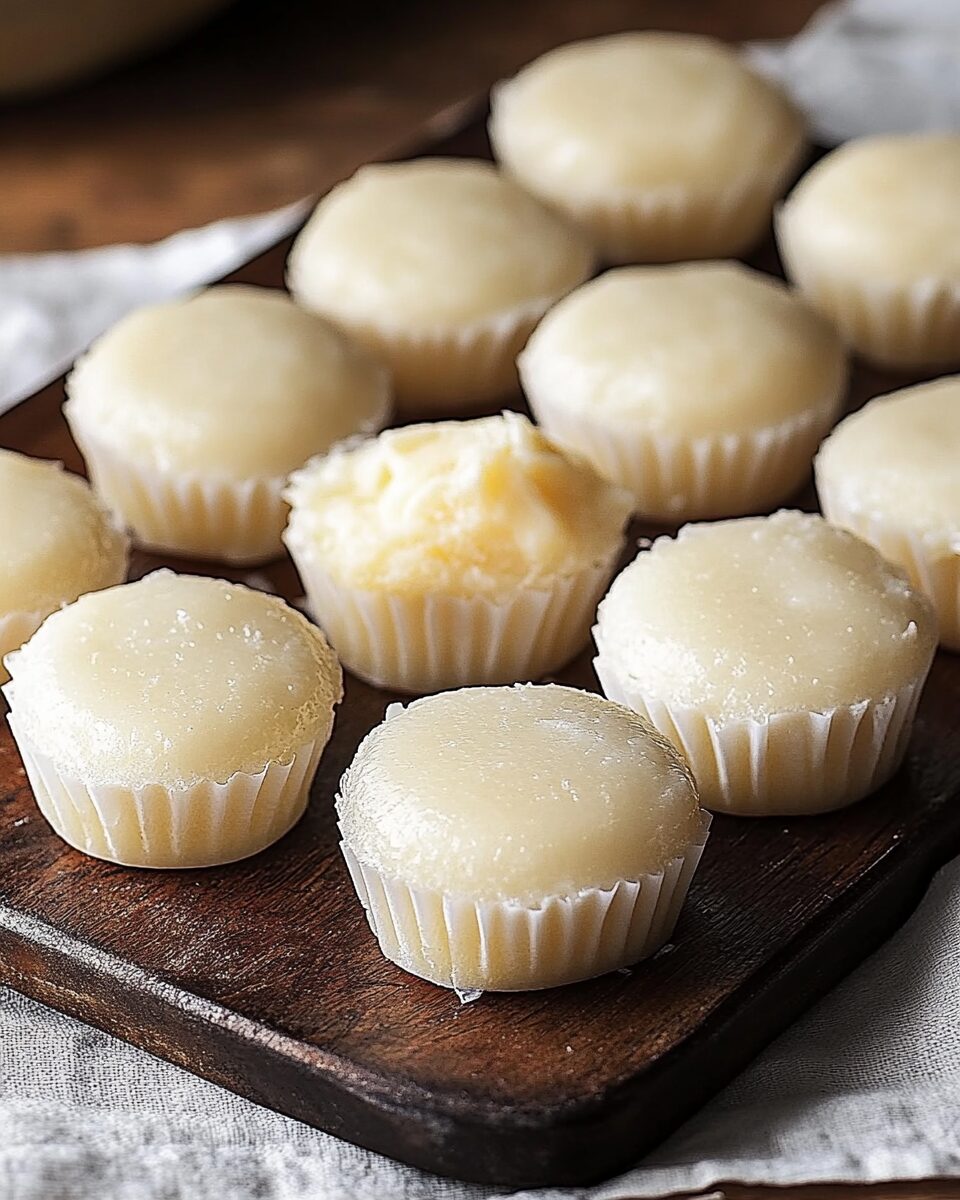Puto is a beloved Filipino snack, commonly served as a side dish or dessert. These soft, fluffy rice cakes are made with rice flour and sugar, offering a subtly sweet flavor with a light texture. Ideal for celebrations or as an everyday treat, puto is enjoyed by people of all ages.
FULL RECIPE
Ingredients
- 1 cup rice flour
- 1/2 cup all-purpose flour
- 1 cup sugar
- 1 tablespoon baking powder
- 1/4 teaspoon salt
- 1 cup coconut milk
- 1/2 cup water
- 1/4 cup butter, melted
- 1 large egg
- 1 teaspoon vanilla extract
- Cheese slices (optional for topping)
Directions
- In a mixing bowl, combine rice flour, all-purpose flour, sugar, baking powder, and salt.
- In a separate bowl, whisk together coconut milk, water, melted butter, egg, and vanilla extract.
- Gradually pour the wet ingredients into the dry ingredients, stirring until smooth and well combined.
- Prepare the steamer by filling it with water and bringing it to a boil. Grease small molds or cupcake tins.
- Pour the batter into the molds, filling each about 2/3 full.
- If desired, place a slice of cheese on top of each puto.
- Steam the puto for about 15-20 minutes or until a toothpick inserted comes out clean.
- Remove from the molds and allow to cool slightly before serving.
Nutritional Information
- Calories: 120-150 per serving
- Carbohydrates: 25-30 grams
- Protein: 2-3 grams
- Fat: 4-6 grams
- Fiber: 1-2 grams
- Sugar: 10-12 grams
History and Origins of Puto
Puto, a beloved Filipino rice cake, has its roots deeply embedded in the country’s history. It is believed that Chinese influence brought the concept of steamed rice cakes to the Philippines, and over time, Filipinos adapted the recipe, incorporating local ingredients like rice flour and coconut milk. This transformation led to the creation of the light, fluffy treat we know today. Over the years, regional variations of puto emerged, showcasing the creativity and resourcefulness of Filipino cooks. Some versions feature toppings like salted eggs and cheese, while others introduce flavors like ube or pandan. These regional twists reflect the diverse culinary heritage of the Philippines.
Cultural Significance of Puto
Puto plays an integral role in Filipino culture, often appearing during celebrations such as Christmas, birthdays, and community gatherings. More than just a treat, it is a symbol of hospitality and togetherness. In Filipino households, offering puto to guests is a way of expressing warmth and generosity. The rice cake is commonly served alongside savory dishes like dinuguan, a rich pork blood stew, creating a harmonious balance of flavors. Its presence at family gatherings and celebrations reflects the Filipino value of unity, where food serves as a connector of people.
Puto Varieties Across the Philippines
While the basic recipe for puto remains consistent, different regions across the Philippines offer their own unique takes on the dish. In the Tagalog region, for example, it’s common to top the puto with cheese, adding a savory contrast to the sweet base. Meanwhile, in other areas like the Visayas and Mindanao, the addition of ube or pandan gives the rice cakes a vibrant color and aromatic flavor. Coconut meat, often used in some variations, adds richness and texture. These regional differences highlight the diversity of Filipino cuisine and the creativity of home cooks.
Puto as a Snack or Dessert
Though often considered a dessert, puto is also a popular snack throughout the day. Its light and airy texture make it a perfect treat for any occasion, whether as a quick bite between meals or paired with a warm cup of coffee or tea. Puto can be served warm or at room temperature, depending on personal preference. Its subtle sweetness and delicate texture make it an ideal snack that appeals to all ages.
The Perfect Pairings for Puto
Puto’s versatility shines when paired with other Filipino dishes. A classic combination is puto with dinuguan, where the rich, savory flavors of the pork blood stew complement the sweetness of the puto. It also pairs well with pancit (Filipino noodles) or lechon (roast pig), providing a neutral base to balance out the savory mains. For a different experience, you can enjoy puto with sweet dips like coconut cream or syrup, enhancing its natural sweetness. Whether savory or sweet, puto’s mild flavor makes it a perfect complement to a variety of Filipino meals.
Cooking Tips for the Best Puto
The key to perfect puto lies in the consistency of the batter. The mixture should be thick yet smooth, with enough body to hold together during steaming. A thin batter may result in soggy cakes, while a too-thick one can cause density. To ensure lightness, make sure to use fresh baking powder and evenly mix it into the dry ingredients. Steaming should be done at medium heat, as this prevents the cakes from overcooking or burning. For easy removal, grease your molds or use silicone cups.
Using Different Flavors in Puto
While traditional puto is delicious on its own, there are plenty of ways to customize the flavor. Ube (purple yam) is a favorite addition, lending both vibrant color and subtle sweetness to the rice cakes. Pandan, known for its fragrant and sweet aroma, is another popular flavoring. Using coconut milk instead of water can create a richer, creamier version of the cake. For a savory variation, cheese or salted eggs can be added to the batter, giving the puto a unique, savory edge.
The Role of Puto in Filipino Festivals
Puto is a mainstay at Filipino festivals, especially during major holidays like Christmas, New Year, and local fiestas. It’s often prepared in large batches and shared with family, friends, and neighbors. The act of preparing puto during these celebrations is a collective family effort, passed down through generations. This shared cooking experience strengthens family ties and keeps the tradition alive. Puto’s presence at festivals is not just about food—it represents unity, joy, and the Filipino spirit of togetherness.
How Puto Is Made for Special Occasions
When prepared for special events, puto is often made in larger quantities to cater to guests. Customization is key for these occasions; puto may be made in vibrant colors or fun shapes, such as hearts for weddings or flowers for birthdays. These personal touches elevate the dish, making it an elegant addition to any celebratory spread. The adaptability of puto ensures it remains a fitting treat for any occasion, no matter how grand or intimate.
Puto’s Nutritional Value
Puto is often seen as a light snack, but like most baked goods, it contains sugar and carbohydrates. While it provides a quick source of energy, it should be consumed in moderation. Coconut milk, a common ingredient, adds healthy fats, but again, this should be considered when watching fat intake. If cheese or salted eggs are included as toppings, they contribute protein and make the puto more filling. While not necessarily a “healthy” food, puto can be enjoyed as part of a balanced diet when consumed in moderation.
Adapting Puto for Healthier Versions
As health consciousness grows, many are looking for ways to make traditional foods like puto more nutritious. Substituting refined sugar with natural sweeteners like coconut sugar or stevia can reduce the sweetness. Replacing white flour with whole wheat flour increases the fiber content, while swapping butter with coconut oil provides a healthier fat option. For those with dairy sensitivities, non-dairy milk such as almond or oat milk can replace cow’s milk without compromising taste. These adjustments allow people to enjoy puto in a way that aligns with their health goals.
Puto and its Popularity Beyond the Philippines
Though traditionally a Filipino dish, puto’s appeal has spread beyond the Philippines, especially in countries with large Filipino communities. In places like the United States, Canada, and the United Arab Emirates, Filipino expatriates have introduced this treat to new audiences. The soft, sweet texture has made it a popular item in Filipino bakeries and restaurants abroad. Its growing popularity is a testament to the international love for Filipino food, with puto gaining recognition as a symbol of Filipino culinary culture.
Puto as a Gift
Food plays a significant role in Filipino culture as a form of expression, and puto is often given as a gift during special occasions. Whether it’s Christmas, a birthday, or a wedding, puto is lovingly prepared and shared with friends and family. Often wrapped in festive boxes or containers, it makes for a thoughtful, personal gift. The act of gifting puto reflects Filipino values of hospitality, kindness, and the importance of sharing with others.
Innovative Takes on Puto
While traditional puto is still beloved, many chefs and home cooks are experimenting with new variations. Matcha powder, chocolate chips, and even caramel have been added to reinvent the classic recipe. Some have even transformed puto into layered cakes with vibrant colors or fillings between layers. These innovative twists on puto keep the dish fresh and exciting while still respecting its roots in Filipino cuisine.
Serving Puto at Gatherings
Presentation matters when serving puto at gatherings. It can be arranged on platters in decorative patterns or served individually in cupcake liners. For added flair, top the puto with shredded coconut, chopped herbs, or extra slices of cheese. Whether it’s a casual snack or a more elaborate dessert, the visual appeal of puto can elevate the entire dining experience, making it a perfect addition to any spread.
Puto in Modern Filipino Cuisine
Modern Filipino chefs are reinterpreting traditional dishes like puto to fit contemporary tastes. In some restaurants, puto is used as a base for more intricate desserts, while others incorporate it into fusion dishes. These modern adaptations help maintain puto’s relevance in the evolving world of Filipino cuisine, ensuring that it continues to appeal to younger generations while honoring its cultural roots.
The Art of Steaming Puto
The steaming process is crucial to achieving the signature texture of puto. Steaming at a consistent, medium heat ensures that the cakes cook evenly and retain their light, fluffy texture. Overcrowding the steamer can result in uneven cooking, so it’s best to steam the puto in batches. The gentle steam allows the flavors to meld, giving the rice cakes their distinct balance of sweetness and tenderness.
Puto as a Breakfast Item
In many Filipino households, puto is enjoyed as part of a traditional breakfast. Paired with savory dishes like longganisa (Filipino sausage) or tocino (sweet cured pork), it provides a satisfying balance of flavors. Puto is also a great accompaniment to a hot cup of coffee or chocolate, making it a perfect way to start the day. Its versatility ensures that it fits seamlessly into various meal settings.
Puto and Its Role in Filipino Street Food
Puto has also become a popular street food in the Philippines. Vendors often sell it as a quick, affordable snack, wrapped in banana leaves or small plastic bags for easy access. Its widespread availability on street corners and markets has made it a staple in Filipino street food culture, further cementing its place in everyday life.
Conclusion
Puto is more than just a Filipino rice cake—it’s a beloved symbol of tradition, community, and innovation. With its rich history, cultural significance, and the many ways it can be enjoyed, puto has earned its place as a cherished part of Filipino cuisine. Whether served as a sweet snack, paired with savory dishes, or featured at special occasions, puto






